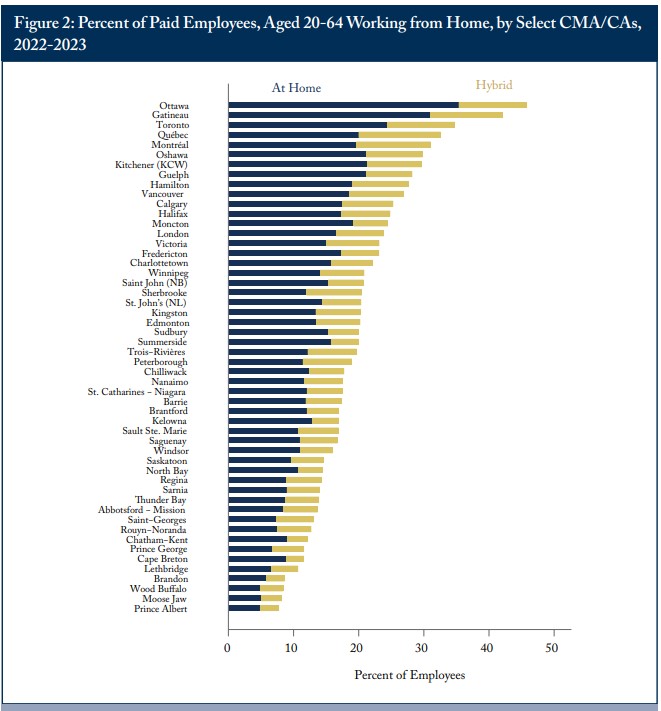'The new normal is for roughly one-quarter of Canadian employees to work from home,' says expert on report’s findings

The number of Canadians who work from home has dropped, according to a recent report from the CD Howe Institute.
At the end of 2023, 26 per cent of paid employees across Canada spent at least part of their week working from home, down from 42 per cent in the spring of 2020, according to the report.
Regionally, Ottawa had a substantial portion of employees working entirely at home (35 per cent) for the 2022-23 year.
Many employees had hybrid arrangements in Ottawa (10 percent), comparable to the portion with hybrid arrangements in other larger centres such as Toronto or Montreal. The portion working from home in several other cities, however, is much smaller.

Source: CD Howe Institute
Earlier this month, the full implementation of the federal government’s return-to-office mandate for workers took effect.
“Several factors might explain these differences across the country, including population density, commuting times, and each region's industry and occupation mix. These factors play a role in whether work-from-home arrangements are feasible from an employer’s point of view and desirable from the employee’s point of view,” says Tammy Schrile, professor in the Department of Economics at Wilfrid Laurier University, in the C.D. Howe Institute report.

Source: CD Howe Institute
The number of commuters in Canada reached 16.5 million in May 2024, continuing an upward trend that followed notable declines recorded during the COVID-19 pandemic in 2020 and 2021, according to the report.
‘New normal’ for remote arrangements
Despite the numbers dropping, Schrile noted in the CD Howe Institute report that “the relatively high portion of jobs that involve remote or hybrid arrangements remains stable”.
“Perhaps the new normal is for roughly one-quarter of Canadian employees to work from home, with a larger portion (over half) working in hybrid arrangements,” she said. “Importantly, those arrangements will be prominent in regions where industries such as finance and insurance,
professional services, or public administration represent a large part of the economy.”
Schrile also highlighted the positive side of remote working, including less cost on office space for employers and no commuting time to work for employees.
However, she also noted that there are costs to consider. For example, “interactions in the workplace are important for employees’ skill development, productive collaboration, and networking,” she said. “Both employers and employees might miss out on opportunities to advance and improve productivity under working-at-home arrangements.”
Adjusting to hybrid work arrangements
The expert concluded that employers and workers still have some adjustments to make when it comes to working arrangements.
“With these challenges in mind, the process of settling into this new normal for work-from-home arrangements may have some unsettling moments, with important policy developments and potentially uncomfortable adjustments required of both employers and employees. In addition to employment standards, provisions to consider include those for home insurance requirements, workplace health and safety rules, digital security, and employee privacy and surveillance,” says Schrile.
“Over time, however, we should look forward to work-from-home arrangements evolving to everyone’s advantage.”
Most Canadian workers are OK with heading back to the office – but employers do not seem to be ready to meet their needs, according to a previous report from Cisco.




